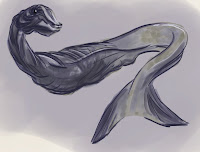Globster
Many globsters have initially been described as gigantic octopuses, although they later turned out to be the decayed carcasses of whales or large sharks. As with the "Chilean Blob" of 2003, many are masses of whale blubber which have been released from decaying whale corpses. Others initially thought to be dead Plesiosaurs later turned out to be the decayed carcases of basking sharks. Others remain unexplained. Giant and colossal squid may also explain some globsters, particularly those which are tentatively identified as monster octopuses.
Some globsters have been examined only after they had decomposed too much to be used as evidence for a new species, or have been destroyed, as happened with the famous "Cadborosaurus willsi" carcass, found in 1937. However, Canadian scientists did in fact perform a DNA analysis of the Newfoundland Blob which indicated that the tissue was from a sperm whale. In their resulting paper, the authors point out a number of superficial similarities between the Newfoundland Blob and other famous globsters, concluding a similar origin for those globsters is likely.[1]

Comments
Post a Comment